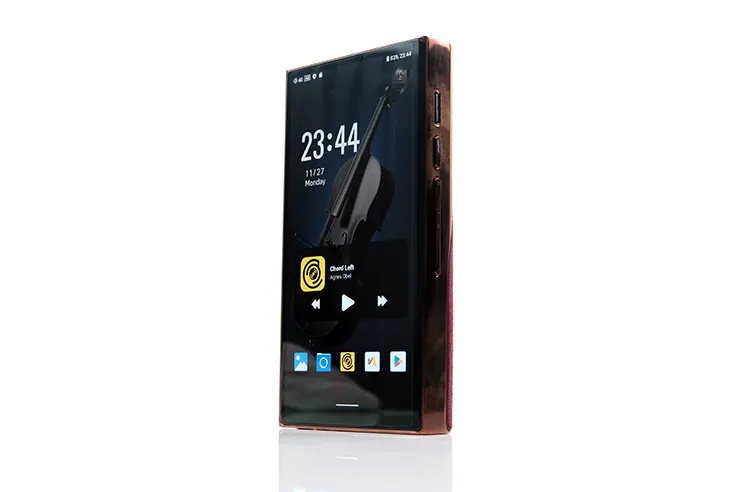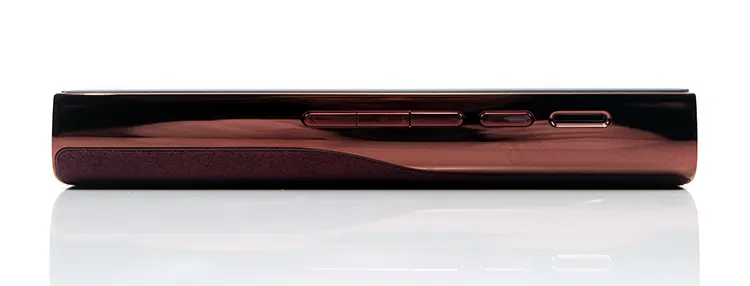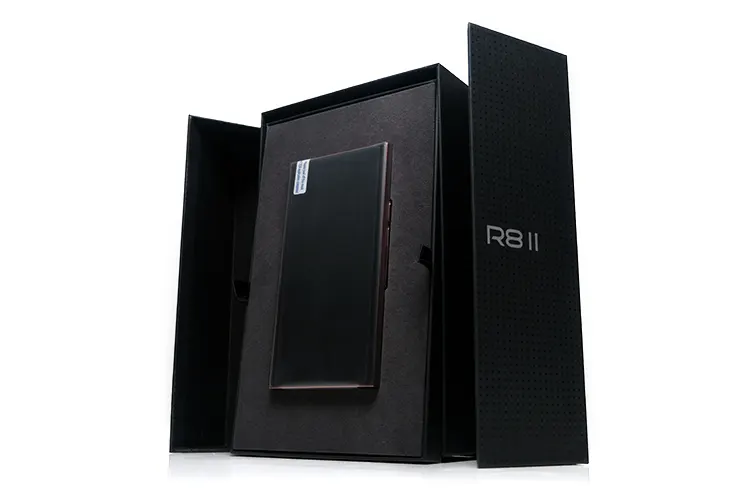We review the HiBy R8 II, which is a new Android 12-equipped digital audio player with a unique in-house-designed discrete DARWIN-MPA DAC. It is priced at $1999 SRP.
Disclaimer: This sample was sent to us in exchange for our honest opinion. Headfonics is an independent website with no affiliate links. We thank HiBy Digital for their support.
You can click here to read more about the HiBy products that we have previously featured on our website.
Note, that this article follows our latest scoring guidelines which you can read in more detail here.
Eight has always been HiBy’s number of choice for their flagship digital audio players from the original R8 in 2020, to the Top Gear Award-winning RS8 in 2022, and now their latest offering, the R8 II.
The RS8 still stands as their flagship DAP for now so the new R8 II, priced at $1999, sits just behind it and replaces the original R8 which is now being phased out.
At this price point, it also has some stiff competition from the likes of the Cayin N7, and FiiO’s monster M17 DAP, not to mention the lure of the RS8 itself.
However, despite not being the flagship offering, the R8 II may well be HiBy’s most technologically advanced player to date. It also brings an outrageously good-looking design to the table much like the R6 Pro II. It’s a looker, but importantly, it’s also a performer.
What is the HiBy R8 II?
The HiBy R8 II is an open Android 12 high-end digital audio player with 8GB of RAM and 256 GB of onboard storage and powered by a Snapdragon 665 CPU.
It is designed primarily to be used with IEMs and a wide range of headphones but can also link up as a transport or source to dedicated DACs and amplifiers.
The R8 II uses a balanced design architecture for amplification in combination with its in-house DARWIN-MPA technology for digital signal management and decoding reaching up to DSD1024 and PCM 32BIT/1536k and also including provision for 16X MQA native unfolding.
What does it do?
The R8 II serves several user requirements. It can be a portable player via HiByMusic with a large 12000mAh battery inside to keep you going for around 11-21 hours depending on your usage.
With BT5.0 support, you can also operate it wirelessly to transmit audio up to LDAC quality to wireless earphones or headphones.
If you fancy a bit of streaming you have the whole Google Play app ecosystem via WiFi 2.G/5G for DLNA, AirPlay, or use it as a Roon endpoint via Roon Arc. Needless to say, the R8 II can be loaded with your favorite streaming apps including TIDAL, Qobuz, and Spotify.
You can also stay at home or in an office and plug the R8 II into your PC/MAC to act as a standalone integrated USB3.2 compatible USB-DAC and amplifier or feed a line-out signal to an analog headphone amplifier of your choice.

What is Darwin-MPA?
The R8 II sees the much-vaunted DARWIN architecture take another leap forward and establish HiBy as an emerging chipset designer in their own right.
This is their first audio player to feature their in-house custom-designed 16-way current mode delta-sigma-based decoder and as such, is a significant break from using off-the-shelf chipsets.
This new decoding process matches the RS8 by offering a class-leading native DSD1024 and will handle PCM to an equally high 32BIT/1536k. The R8 II also retains the 16X MQA and DTA bitperfect architecture decoding capability of the original R8.
However, this is only one part of their new generation DARWIN-MPA architecture, (Multiphase PWM array). The previous DARWIN II R-2R framework provided HiBy with an essential foundation and perhaps a learning basis to allow them to move to a more expansive design.
At the high level, Darwin-MPA is an end-to-end Hi-Res audio processing design that incorporates everything that happens before, leading up to, and including the delta-sigma-based decoding.
That includes innovative features such as its DSD bypass, even higher oversampling than before at 128FS compared to the previous 16FS, as well as linear phase control through an enhanced 1024-tap cascaded FIR filter system.
Think of it as an approach not too dissimilar to Chord Electronics’ in-house FPGA-based DAC and dCS’s discrete-designed Ring DAC.
Dual Amplification
The R8 II retains the distinctive dual operational mode for both its balanced and single-ended amplification output.
That means you can switch from either a Class A mode or a Class AB mode during playback via the OS with a simple finger press to get two distinctive amplification performances. There is no variation in rated power for either mode, both will output the same Vrms/mW levels.
Both options are compatible with HiBy’s Turbo Mode feature which is something I tend to turn on and forget about unless I want to lengthen the battery life per charge as it can be a bit intensive.
For those new to Turbo mode increases the default voltage supply by 25% enhancing the dynamics with both IEM and headphones. In this instance, the default ±6V is raised by 1.5V to ±7/5V.

Performance Numbers
Despite being below the RS8, I find the R8 II performance capability gap to be quite narrow, at least on paper.
There is just a minor drop in RMS from 780mW to 710mW when going balanced on the R8 II with single-ended going from 280mW down to 225mW. I see no issues on the official output impedance either at 1Ω for both outputs.
The rated line-out Vrms is also unchanged from the RS8 and the original R8 at 4Vrms balanced and 2Vrms single-ended.
Where this comparison will get interesting is how it handles noise and the dynamic range during playback, especially with IEMs. The R8 II offers an 11 dB additional dynamic range over the flagship RS8 and a further 3 dB over the original R8.
Whilst we should expect R-2R to usually offer lower numbers in these areas the jump is still noteworthy and it is something I immediately picked up in the R8 II’s performance, particularly with how black the background was with IEMs.
Design
Aesthetics
The design of the R8 II is nothing short of gorgeous. The R6 II Pro was but an early indicator of the potential of HiBy’s out-of-the-box thinking when it comes to a portable device finishing.
Whilst the R8 II’s shape is not as physically ‘contorted’, its finishing and color selection is exquisite. Is this the first DAP with an Alcantara back panel? Correct me if I am wrong but I think it is.
Not only that, but we have 3 matching color schemes for both the stainless steel main body and the Alcantara to give you a beautifully integrated aesthetic.
This version is the official ‘red’ with the other two in black and blue but that description does not do it justice. I would define it as more of a mix of burgundy for the Alcantara-wrapped rear panel and a very polished and reflective dark carmine for the stainless steel body.
Of course, Alcantara brings with it a different approach to protective management since it is a material rather than just stainless steel.
HiBy has supplied a hybrid silicone and Alcantara coated case that will work quite well. I would recommend you slot the R8 II in the case right away, especially if in a humid environment to protect the material from liquids and dust.
Form Factor
If you are an RS8 or R8 owner you are going to notice right away that the R8 II has the largest form factor measuring 149x78x23mm.
Thankfully, it is not the heaviest of the three DAPs at 515g which is 69g less than the RS8’s titanium housing. It is, however, 89g heavier than the original R8 which uses an aluminum housing as opposed to stainless steel.
There was some talk pre-R8 launch of a stainless steel version but it never made it to the market as far as I know so, in some ways, the R8 II is a revisit to that intention and is now consistent with the older R6 debut launch whose housing was also stainless steel.
Battery Life
One other key component here that adds to the weight is the hefty 12000mAh battery inside which looks like it might be the same as the 12000mAh version inside the RS8.
The R8 was loaded with a 38Wh ATL custom battery 10000mAh/3.8V equivalent which gave me about 9-10 hours with the big 1080p screen on at full brightness. I was getting closer to 11-12 hours plus with some lossy tracks and the screen off.
With this new battery, I am sailing through maybe around 8 hours easily from 85% down to 30% using Turbo mode, full brightness, going balanced on a 20Ω load. I say 85% because my best tip for retaining good battery health is to set the battery maximum to 85% after your first initial drain.
Screen
A lot of the extended size is due to the new larger 5.9″ IPS screen with a 2:1 ratio replacing the long-serving squatter 5.5″ screen HiBy used in both the R8 and the RS8.
That should give you a bit more screen real estate for media management lists and a little bit less time scrolling. Not only is it bigger but its bezel is slightly slimmer and with better curving.
The screen resolution itself has gone from 1080P to 1080P Plus. This offers an enhanced 1080 x 2160 resolution as opposed to 1080 x 1920 with an improved pixel density of 402ppi over 387dpi.
In my testing of the R8 II, the text and icons were more refined looking with an enhanced color saturation compared to the older screen. The touchscreen responsiveness is also excellent and much faster also than the original R8 with improved RAM.
I/O
The one area that is very consistent with the previous models is the I/O array, both in terms of placement and options.
All are located on the base panel with the PO split from the LO so there is use of multifunctional ports. Both the balanced 4.4mm and SE 3.5mm ports are to the left and LO equivalent is to the far right.
In the middle is the new USB 3.2 compatible USB-C port and it is multifunctional allowing you to charge, data transfer, and convert the R8 II into a USB-DAC with the supplied USB-C cable.
The R8 II USB-C port should be able to operate as a coaxial port with the correct cable, however, it does not come with a USB-C to coaxial conversion cable which might be missed by RS8 and R8 owners.
At the top of the right panel, there is also an open memory slot for MicroSD cards with the R8 II rated for up to 2TB cards to go alongside the massively increased 256Gb of onboard memory. Will you need that slot? Perhaps not but useful to have for those with big DSD collections.
Physical Controls
Perhaps the first thing you will notice on the R8 II is the lack of a physical dial or Alps volume wheel which was present in the previous iterations of the R8. That has now been replaced by a relatively discreet and slim volume rocker on the left panel.
I am in two minds about the loss of the wheel. For some, the wheel is easier to use, more visible, and can be quickly accessed for minute adjustments. The volume rocker might be harder to locate sight unseen with the Alcantara-lined case covering it.
However, there are also the design benefits of losing the dial allowing HiBy to produce a more streamlined chassis as well as introduce additional protection against potential pot pitting and degradation of the performance.
The rocker is also very accurate, more so than the RS8 wheel which tended to have difficulty in recognizing very short rotational movements meaning the volume was never changed.
The rest of the physical buttons have also undertaken a similar transformation down the right panel going from vertical to horizontal. They do look sleeker and since they will be covered by the new case they will be better protected from dust compared to the R8 and RS8 placement.
The functional lineup is unchanged with playback behind the slightly raised power button but again, the thick Alcantara case makes them slightly trickier to find and access when sight unseen.
Packaging & Accessories
The R8 II packaging is not as grandiose as the launch packaging for the original R8 or the RS8 ensemble.
Having said that, the last iteration of the R8 seems to have done away with the leather case extravaganza which is a shame but perhaps costs needed to be diverted elsewhere. If you want the full leather briefcase experience then there is always the flagship RS8 which still uses it.
That is not to say the unboxing experience is a joyless experience. Rather it’s more in line with what you would expect from any other high-end DAP. The split lid articulation is very presentable with the R8 II on top and all the accessories underneath including the case.
You do get a little something new in the accessory line-up aside from the USB-C cable, case, and warranty cards, and that is a set of port protector films. It’s new to me and an innovative approach to protecting the base of your DAP or damage from your jacks.
Hybrid Case
DAP cases generate so much debate it’s unreal. Usually, it’s a leather case that is either too loose over time, has too much travel to the buttons, or is simply poorly made.
The R8 II comes with something I would define as a hybrid case. This is primarily a thick Bayer UE95 TPU or a ‘silicone’ case with an interesting mix of Alcantara on the exterior left and right panels.
It’s a clever idea to extend the theme before the unit itself. If you are wondering why not just make a matching color leather case well I suspect the Alcantara back wouldn’t last too long with either gaps on the rear of the case or a metal panel to let heat escape. A TPU case is much better and a lot kinder friction-wise.
It’s not all winning though. It’s a thick case, and the ports are quite recessed so it is possible some plugs might not fit in as easily. For example, the bulky Unique Melody Multiverse Mentor 4.4mm plug from their Deep of Universe cable fits just fine but the Dan Clark Audio VIVO 4.4mm terminated cable will not.
Click on page 2 below for software impressions.
Click on page 3 below for sound impressions and recommended pairings.











